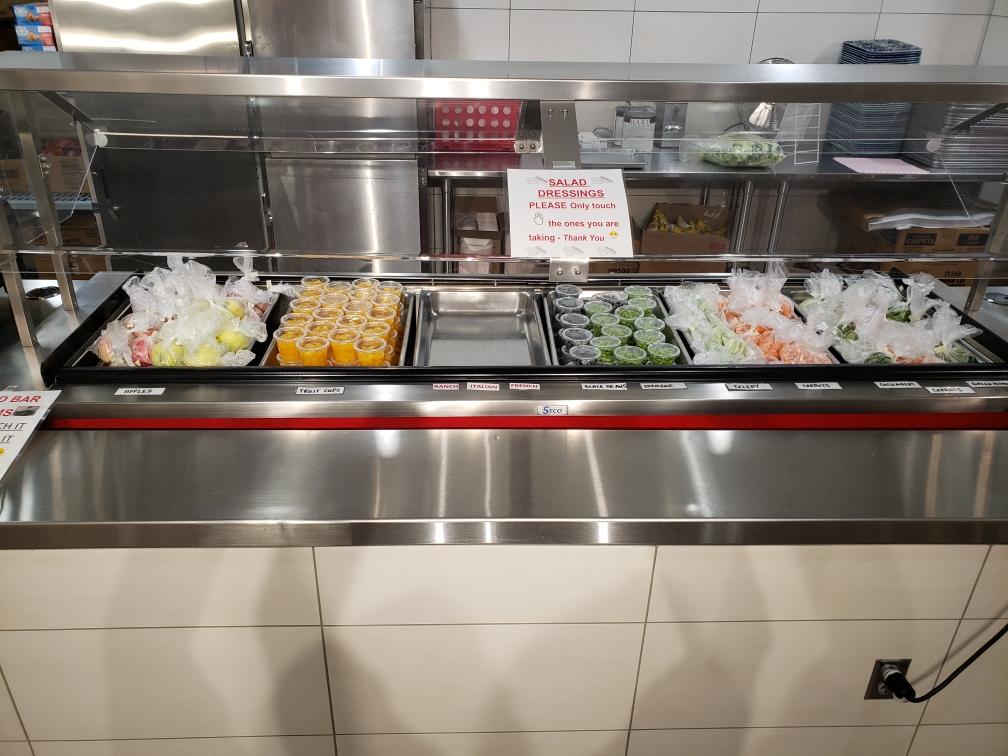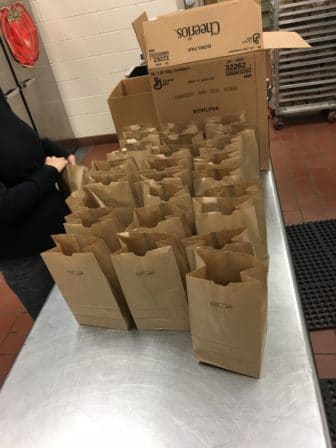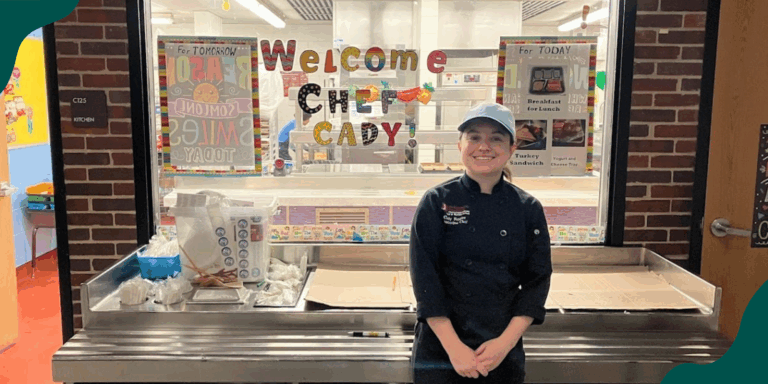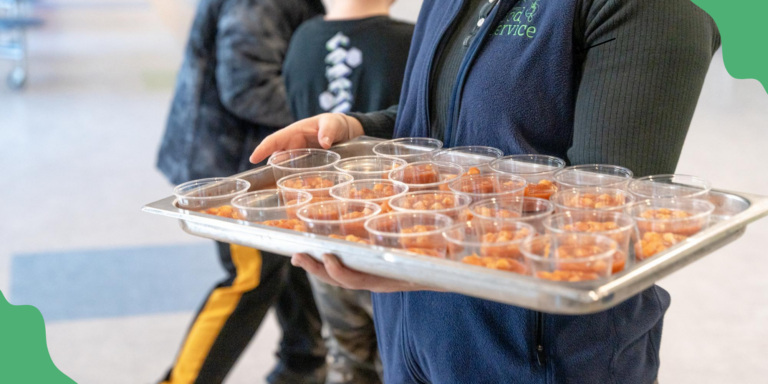National School Lunch Week: Inside School Lunch Across the Country
This National School Lunch Week, we look at how COVID-19 has reimagined school lunch service in three different communities.
This National School Lunch Week, we look at how COVID-19 has reimagined school lunch service in three different communities.

In 1962, a joint resolution by Congress established National School Lunch Week (NSLW), annually observed the second full week of October. To mark NSLW 2020, FoodCorps is highlighting the resilient spirit of our nation’s school nutrition professionals. Whether continuing to serve meals from curbside locations and bus routes, delivering all meals to classrooms, or serving in reopened cafeterias, they are happy to reconnect with student customers in even the most socially distant ways.
But their positivity shouldn’t mask genuine concerns about the ever-evolving challenges of this unprecedented school year, which remain daunting. Low school meal participation among remote learners is a financial worry, but operators are even more troubled by what the numbers suggest about meals failing to get to children in food-insecure households. Meet three school nutrition professionals trying to balance uncertainty and optimism in the early days of the school year.
“It’s nice to be back. It was a long spring and summer,” says Ailish Dennigan, Food Services Team Leader at East End Community School, in Maine’s Portland Public Schools system. Dennigan, a former FoodCorps service member, is beginning her second year in school nutrition, so her professional experience has been honed in less than “typical” circumstances. Despite the pervasive ambiguities and repeated pivots common to all school districts since March, Dennigan remains up for the challenge. “Even with all the changes, I love feeling a part of the school community,” she says.

This school year, which began September 14, East End Community is taking a hybrid approach, with two groups of students in school twice a week for a shortened schedule (dismissal is at 12:30 p.m.), and everyone doing remote learning on Wednesdays. Some parents are opting to keep their children at home for virtual learning full-time.
What has and hasn’t changed about Dennigan’s pre- and post-pandemic meal service responsibilities are clear reflections of current conditions. Last year’s salad bar preparation tasks are sadly unnecessary this year. Her previous experience coordinating breakfast deliveries to classrooms, however, has been helpful in transitioning lunch and snack service to this model. There’s no curbside meal pickup at East End Community, so Dennigan doesn’t have to manage that complication; instead, she anticipates being assigned to the district’s central kitchen on all-remote Wednesdays.
But there is one particularly lamentable change: little to no interaction with students. “Our meal service model doesn’t allow for the same relationship-building with the students, and that piece is a bummer,” says Dennigan. To keep contact to a minimum, cooler bags packed with meals are set outside each classroom. Teachers bring these “meal mailboxes” inside when they are ready to serve. The process starts with breakfast and is repeated for snacks and lunches. While she misses engaging directly with children in the cafeteria, Dennigan takes comfort in just being able to walk around the school, hearing snippets of conversation from open classroom doors and enjoying even this smallest touchstone with normalcy.
Less than a month into the new school year, Dennigan has been primarily focused on “getting the meal numbers right,” as families, children, teachers and school nutrition professionals alike adjust to the hybrid approach. “It was a real puzzle to manage the different meals and different days,” she explains, also citing the complications of a few product shortages (cereal bars, for example) that impact a student’s choice to take a meal. As routines become more established, she hopes to have time to add little notes into pre-packed student meals, request a bulletin board to decorate with food-connection messages, and think ahead about what she can do in the cafeteria “to make it a welcoming space when it does reopen.”
“Our cooks are so happy to be back in the kitchens,” reports Michelle Wagner, RD, SNS, Child Nutrition Director for Bismarck Public Schools in North Dakota. Even though there are fewer children in the district’s school buildings right now, and limited opportunities to engage with students, Wagner’s team members are pleased to return. “They told me, ’We just want to come in and cook for the kids.’ They want to provide kids with real food, served hot and in person, rather than only providing a frozen take-home meal and hoping it gets cooked and consumed,” says Wagner.
With 13,000 students at 22 schools, Bismarck is the largest school district in the state—and it’s still growing, with two new elementary sites under construction. At the start of school at the end of August, the district adopted a hybrid approach for all grade levels, with students in schools twice weekly. All meals are currently served in the cafeteria, but they may be eaten in the dining area or taken back to classrooms, depending on the site and schedule.
Beginning in late September, the district began to transition select grades to full-time in-school learning, anticipating having all K-12 students back in schools by the end of October. But with COVID-19 numbers that “are going through the roof in our state, especially in this county,” Wagner is bracing for the possibility of yet another pivot in the weeks to come.
“It’s been a total rollercoaster. You have your ups, then downs. As soon as you have a plan, you have to do a 180 and then it changes again,” she says. An added source of anxiety has been a struggle to fill some vacancies in her department. “We’re not getting any applications, and that’s really odd,” says Wagner, comparing this to other years. “And then if and when we go back to full face-to-face learning…?” There’s obvious anxiety about how they will manage the transition while also providing multi-day meal kits to families who choose to stay in an all-virtual learning mode.
With new wrinkles in meal service, prep time, the availability of products and PPE, staffing, the specter of a sudden shutdown and other factors, Wagner has had no choice but to cut back on the total number of menu choices offered, as well as eliminating some of the trend-forward options that were popular among the students. And with a 60% drop in overall participation since March, she worries that menu “sameness,” even with scratch-prepared hot and cold entrée choices, might have a further dampening effect.
“For kids in school, participation has been holding steady, but I thought it would jump when we announced that all meals are free,” she says. And with decreased meal participation numbers among remote learners, “I’m losing sleep over the decrease in revenue that we’re seeing and how that will eventually affect staffing,” she says.
Once she has the bandwidth, Wagner wants to focus on developing a better strategy for managing distance and quarantine meals, and to amp up her overall marketing efforts. And although “innovation is on the backburner for now,” she is pleased to have expanded breakfast-in-the-classroom service at two new elementary sites this fall, plus she knows she has a long list of other projects ready to launch “when things settle down.”
In the meantime, she’s grateful for her team: “They make my job pleasurable, and I enjoy coming to work, no matter what we’re faced with. They have such a positive attitude.” Personally, she’s trying to exercise more, do some meditation, and listen to podcasts that emphasize positivity. “I just try to keep it day by day and hour by hour. It also helps to know that it’s not always going to be like this. There is a light at the end of the tunnel. There will be relief, whether that’s six months or a year from now.”
“What we heard from parents was that their kids miss the hot lunches. So that’s how we started our new school year,” says Gail Sharry, Executive Director, Food Services, New Haven Public Schools (NHPS) in Connecticut. What’s notable is that Sharry’s team is preparing made-to-order hot lunches available at school every day for remote learners. The district began with a 100% virtual learning model for at least the initial weeks of the fall.

In this somewhat unique take on curbside meal distribution, students place an order online and pick up their takeout meal from the school site. It is prepared inside, but delivered to the customer at an outdoor station. If the weather cooperates, kids may opt to eat on campus grounds or take the meals off-site. Menus are available online and feature one hot entrée and three to four cold options. Offerings include several favorites of the typical school year, such as Roasted Chicken and Whole-Grain Waffles, Stuffed Shells and Garlic Bread, Pinwheel Calzones, and BBQ Beef Ribs. “Some of the site managers are ready to add a second hot choice,” says Sharry. “They miss the kids, and they miss cooking.”
The NHPS Food Services team has had a tumultuous year. “We never closed to [serving] meals. We did not stop. Staff even worked through their spring vacation,” says Sharry, adding, “Two of our staff members came down with COVID and one was hospitalized. They both recovered and are happy to be able to cook again.”
Sharry and her team are grateful that students miss their signature dishes, and providing flexibility to meet customer demand is the new name of the game. “We’ve done a little bit of everything to increase participation,” she says, including tweaking meal pickup times. Such efforts are critical to the operation’s financial sustainability, a driving factor behind Sharry’s hire eight years ago. At the district’s 41 serving sites, they’d typically serve 8,000 breakfasts and 15,000 lunches each day to an enrollment of 23,000 students. Right now, participation hovers in the 2,000-2,500 range, which actually is a huge increase from the first few days of school.
“We’d like to get that up to at least 5,000 to 6,000 meals daily,” Sharry notes, adding that a weekend meal service is about to be launched, which will help bring in revenue and fill the hunger gap. “Support from the district administration has been great. They’ve promoted meals through robocalls, emails…one school invited the Food Services site manager to be on a Zoom call with parents,” she reports. “We know there’s a lot of need out there in the city for meals.”
A passionate advocate of FoodCorps’ mission, Sharry hasn’t let COVID-19 sideline her two service members. They continue to conduct various projects, including offering taste tests at tables set up outside school sites, encouraging kids and their parents to sample unfamiliar ingredients and dishes. They’ve created recipe cards for sampled items and include these in take-home packages. “If we can’t get into the schools, maybe we can do a Zoom activity,” says Sharry, who also points to opportunities for in-person connections at “learning hubs” being organized at area Boys & Girls Clubs.
No stranger to collaborative efforts, Sharry has partnered with the culinary high school teacher on an education initiative. Students in the program are provided individual meal kits featuring her products and the teacher’s recipes to help them learn about measures, weights, writing recipes, and meal prep. “He’s invited our FoodCorps service members to come watch him do it and then they can create a similar kit that gets sent home to students,” she says.
In September, NHPC signed on to distribute USDA’s Farmer Food Boxes, which were hugely popular, but after learning that another community organization is also distributing these elsewhere in the city, she’s considering redirecting her team’s efforts toward other projects this fall.
When asked where she finds optimism as the school year unspools, Sharry laughs. And laughs. Finally, she says, “I’m enjoying the better weather. The humidity is over and that helps me the most. Now, I’m just hoping we can get through this and get to a day where we don’t have to wear face masks.”

The Policy Brief: 2025 State Policy Updates

Alumni Spotlight: Cady Molloy, School District Executive Chef

6 Careers in Food That Make a Difference